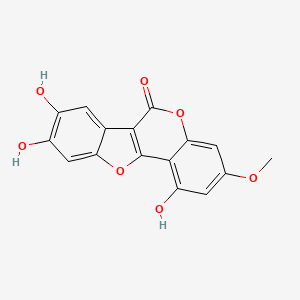| MeSH term | MeSH ID | Detail |
|---|---|---|
| Alopecia | D000505 | 14 associated lipids |
| Prostatic Neoplasms | D011471 | 126 associated lipids |
| Melanoma | D008545 | 69 associated lipids |
| Glioma | D005910 | 112 associated lipids |
| Neuroblastoma | D009447 | 66 associated lipids |
| Carcinoma, Hepatocellular | D006528 | 140 associated lipids |
| Atherosclerosis | D050197 | 85 associated lipids |
Wedelolactone
Wedelolactone is a lipid of Polyketides (PK) class. Wedelolactone is associated with abnormalities such as CLEFT LIP, CONGENITAL HEALED and Hepatitis. The involved functions are known as Signal Transduction, Cell Cycle Arrest, Apoptosis, luciferase activity and Metabolic Inhibition. Wedelolactone often locates in Protoplasm and Smooth muscle (tissue). The associated genes with Wedelolactone are CFB gene, Candidate Disease Gene, JAK2 gene, STAT2 gene and STAT3 gene.
Cross Reference
Introduction
To understand associated biological information of Wedelolactone, we collected biological information of abnormalities, associated pathways, cellular/molecular locations, biological functions, related genes/proteins, lipids and common seen animal/experimental models with organized paragraphs from literatures.
What diseases are associated with Wedelolactone?
Wedelolactone is suspected in CLEFT LIP, CONGENITAL HEALED, Hepatitis and other diseases in descending order of the highest number of associated sentences.
Related references are mostly published in these journals:
| Disease | Cross reference | Weighted score | Related literature |
|---|
Possible diseases from mapped MeSH terms on references
We collected disease MeSH terms mapped to the references associated with Wedelolactone
PubChem Associated disorders and diseases
What pathways are associated with Wedelolactone
There are no associated biomedical information in the current reference collection.
PubChem Biomolecular Interactions and Pathways
Link to PubChem Biomolecular Interactions and PathwaysWhat cellular locations are associated with Wedelolactone?
Visualization in cellular structure
Associated locations are in red color. Not associated locations are in black.
Related references are published most in these journals:
| Location | Cross reference | Weighted score | Related literatures |
|---|
What functions are associated with Wedelolactone?
Related references are published most in these journals:
| Function | Cross reference | Weighted score | Related literatures |
|---|
What lipids are associated with Wedelolactone?
There are no associated biomedical information in the current reference collection.
What genes are associated with Wedelolactone?
Related references are published most in these journals:
| Gene | Cross reference | Weighted score | Related literatures |
|---|
What common seen animal models are associated with Wedelolactone?
There are no associated biomedical information in the current reference collection.
NCBI Entrez Crosslinks
All references with Wedelolactone
Download all related citations| Authors | Title | Published | Journal | PubMed Link |
|---|---|---|---|---|
| da Silva AJM PA et al. | Synthesis and preliminary pharmacological evaluation of coumestans with different patterns of oxygenation. | 2001 | Bioorg. Med. Chem. Lett. | pmid:11212092 |
| Lin WL et al. | Ethyl acetate extract of Wedelia chinensis inhibits tert-butyl hydroperoxide-induced damage in PC12 cells and D-galactose-induced neuronal cell loss in mice. | 2014 | BMC Complement Altern Med | pmid:25510435 |
| Lans C et al. | Medicinal and ethnoveterinary remedies of hunters in Trinidad. | 2001 | BMC Complement Altern Med | pmid:11737880 |
| Tanabe K et al. | Mechanisms of interleukin-1beta-induced GDNF release from rat glioma cells. | 2009 | Brain Res. | pmid:19362079 |
| Rowe DL et al. | Modulation of the BRCA1 Protein and Induction of Apoptosis in Triple Negative Breast Cancer Cell Lines by the Polyphenolic Compound Curcumin. | 2009 | Breast Cancer (Auckl) | pmid:19809577 |
| Patrikidou A et al. | Inverse baseline expression pattern of the NEP/neuropeptides and NFκB/proteasome pathways in androgen-dependent and androgen-independent prostate cancer cells. | 2011 | Cancer Cell Int. | pmid:21569620 |
| Benes P et al. | Inhibition of topoisomerase IIα: novel function of wedelolactone. | 2011 | Cancer Lett. | pmid:21315506 |
| Lin FM et al. | Compounds from Wedelia chinensis synergistically suppress androgen activity and growth in prostate cancer cells. | 2007 | Carcinogenesis | pmid:17942463 |
| Bharadwaj U et al. | Mesothelin overexpression promotes autocrine IL-6/sIL-6R trans-signaling to stimulate pancreatic cancer cell proliferation. | 2011 | Carcinogenesis | pmid:21515913 |
| Malara N et al. | Simultaneous inhibition of the constitutively activated nuclear factor kappaB and of the interleukin-6 pathways is necessary and sufficient to completely overcome apoptosis resistance of human U266 myeloma cells. | 2008 | Cell Cycle | pmid:18931595 |
